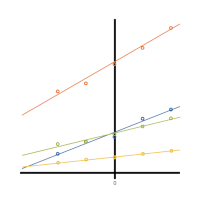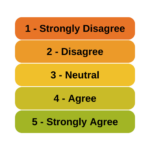 Centering variables is common practice in some areas, and rarely seen in others. That being the case, it isn’t always clear what are the reasons for centering variables.
Centering variables is common practice in some areas, and rarely seen in others. That being the case, it isn’t always clear what are the reasons for centering variables.  Is it only a matter of preference, or does centering variables help with analysis and interpretation? (more…)
Is it only a matter of preference, or does centering variables help with analysis and interpretation? (more…)
Some repeated measures designs make it quite challenging to specify within-subjects factors. Especially difficult is when the design contains two “levels” of repeat, but your interest is in testing just one.
Let’s look at a great example of what this looks like and how to deal with it in this question from a reader :
The Design:
I want to do a GLM (repeated measures ANOVA) with the valence of some actions of my test-subjects (valence = desirability of actions) as a within-subject factor. My subjects have to rate a number of actions/behaviours in a pre-set list of 20 actions from ‘very likely to do’ to ‘will never do this’ on a scale from 1 to 7, and some of these actions are desirable (e.g. help a blind man crossing the street) and therefore have a positive valence (in psychology) and some others are non-desirable (e.g. play loud music at night) and therefore have negative valence in psychology.
My question is how I can use valence as a within-subjects factor in GLM. Is there a way to tell SPSS some actions have positive valence and others have negative valence ? I assume assigning labels to the actions will not do it, as SPSS does not make analyses based on labels …
Please help. Thank you.
(more…)
 Is it really ok to treat Likert items as continuous?
Is it really ok to treat Likert items as continuous?  And can you just decide to combine Likert items to make a scale? Likert-type data is extremely common—and so are questions like these about how to analyze it appropriately. (more…)
And can you just decide to combine Likert items to make a scale? Likert-type data is extremely common—and so are questions like these about how to analyze it appropriately. (more…)
When your dependent variable is not continuous, unbounded, and measured on  an interval or ratio scale, linear models don’t fit. The data just will not meet the assumptions of linear models. But there’s good news, other models exist for many types of dependent variables.
an interval or ratio scale, linear models don’t fit. The data just will not meet the assumptions of linear models. But there’s good news, other models exist for many types of dependent variables.
Today I’m going to go into more detail about 6 common types of dependent variables that are either discrete, bounded, or measured on a nominal or ordinal scale and the tests that work for them instead. Some are all of these.
(more…)
One of the difficult decisions in mixed modeling is deciding which factors are fixed and which are random. And as difficult as it is, it’s also very important. Correctly specifying the fixed and random factors of the model is vital to obtain accurate analyses.
Now, you may be thinking of the fixed and random effects in the model, rather than the factors themselves, as fixed or random. If so, remember that each term in the model (factor, covariate, interaction or other multiplicative term) has an effect. We’ll come back to how the model measures the effects for fixed and random factors.
Sadly, the definitions in many texts don’t help much with decisions to specify factors as fixed or random. Textbook examples are often artificial and hard to apply to the real, messy data you’re working with.
Here’s the real kicker. The same factor can often be fixed or random, depending on the researcher’s objective. (more…)
 Have you ever wondered why there are so many different types of experimental designs, and how a researcher would go about choosing among them to best address their research questions? (more…)
Have you ever wondered why there are so many different types of experimental designs, and how a researcher would go about choosing among them to best address their research questions? (more…)
 Centering variables is common practice in some areas, and rarely seen in others. That being the case, it isn’t always clear what are the reasons for centering variables.
Centering variables is common practice in some areas, and rarely seen in others. That being the case, it isn’t always clear what are the reasons for centering variables.  Is it only a matter of preference, or does centering variables help with analysis and interpretation? (more…)
Is it only a matter of preference, or does centering variables help with analysis and interpretation? (more…)

 And can you just decide to combine Likert items to make a scale? Likert-type data is extremely common—and so are questions like these about how to analyze it appropriately.
And can you just decide to combine Likert items to make a scale? Likert-type data is extremely common—and so are questions like these about how to analyze it appropriately.